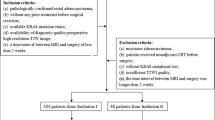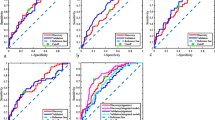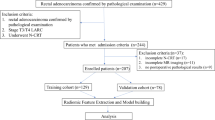Summary
The mutation status of KRAS is a significant biomarker in the prognosis of rectal cancer. This study investigated the feasibility of MRI-based radiomics in predicting the mutation status of KRAS with a composite index which could be an important criterion for KRAS mutation in clinical practice. In this retrospective study, a total of 127 patients with rectal cancer were enrolled. The 3D Slicer was used to extract the radiomics features from the MRI images, and sparse support vector machine (SVM) with linear kernel was applied for feature reduction. The radiomics classifier for predicting the KRAS status was then constructed by Linear Discriminant Analysis (LDA) and its performance was evaluated. The composite index was determined with LDA model. Out of 127 rectal cancer subjects, there were 44 KRAS mutation cases and 83 wild cases. A total of 104 radiomics features were extracted, 54 features were filtered by linear SVM with L1-norm regularization and 6 features that had no significant correlations within them were finally selected. The radiomics classifier constructed using the 6 features featured an AUC value of 0.669 (specificity: 0.506; sensitivity: 0.773) with LDA. Furthermore, the composite index (Radscore) had statistically significant difference between the KRAS mutation and wild groups. It is suggested that the MRI-based radiomics has the potential in predicting the KRAS status in patients with rectal cancer, which may enhance the diagnostic value of MRI in rectal cancer.
Similar content being viewed by others
Change history
14 May 2021
The correct author name GUO is correct given in the PDF file, but tagged incorrectly to QUO.
References
Freddie IB, Jacques F, Isabelle S, et al. Global Cancer Statistics 2018: GLOBOCAN Estimates of Incidence and Mortality Worldwide for 36 Cancers in 185 Countries. CA Cancer J Clin, 2018,68(6): 394–424
Siddiqui AD, Piperdi B. KRAS mutation in colon cancer: a marker of resistance to EGFR-I therapy. Ann Surg Oncol, 2010,17(4):1168–1176
Stintzing S, Modest DP, Rossius L, et al. FOLFIRI plus cetuximab versus FOLFIRI plus bevacizumab for metastatic colorectal cancer (FIRE-3): a post-hoc analysis of tumour dynamics in the final RAS wild-type subgroup of this randomised double-blind phase 3 trial. Lancet Oncol, 2016,17(10): 1426–1434
Venook AP, Niedzwiecki D, Lenz HJ, et al. Effect of First-Line Chemotherapy Combined With Cetuximab or Bevacizumab on Overall Survival in Patients With KRAS Wild-Type Advanced or Metastatic Colorectal Cancer: A Randomized Clinical Trial. Jama, 2017,317(23): 2392–2401
Bokemeyer C, Bondarenko I, Hartmann JT, et al. KRAS status and efficacy of first-line treatment of patients with metastatic colorectal cancer (mCRC) with FOLFOX with or without cetuximab: The OPUS experience. Grune & Stratton, 2008,26(15): 753–754
Van C E, Lang I, D’Haens G, et al. KRAS status and efficacy in the first-line treatment of patients with metastatic colorectal cancer (mCRC) treated with FOLFIRI with or without cetuximab: The CRYSTAL experience. J Clin Onco, 2008,26(15): 431–436
Scrivener M, De Jong EE, Van Timmeren JE, et al. Radiomics applied to lung cancer: A review. Transl Cancer Res, 2016,5(4): 398–409
Limkin EJ, Sun R, Dercle L, et al. Promises and challenges for the implementation of computational medical imaging (radiomics) in oncology. Ann Oncol, 2017,28(6): 1191–1206
Huang YQ, Liang CH, He L, et al. Development and validation of a radiomics nomogram for preoperative prediction of lymph node metastasis in colorectal cancer. J Clin Oncol, 2016,34(18): 2157–2164
Maffione AM, Marzola MC, Capirci C, et al. Value of (18)F-FDG PET for Predicting Response to Neoadjuvant Therapy in Rectal Cancer: Systematic Review and Meta-Analysis. Am J Roentgenol, 2015,204(6): 1261–1268
Nie K, Shi L, Chen Q, et al. Rectal Cancer: Assessment of Neoadjuvant Chemoradiation Outcome based on Radiomics of Multiparametric MRI. Clin Cancer Res, 2016,22(21): 5256–5264
Dinapoli N, Barbaro B, Gatta R, et al. MR radiomics predicting complete response in radiochemotherapy (RTCT) of rectal cancer (LARC). Poster presented at: 35th ESTRO, 2016 April 29–May, Turin, Italy
Ng F, Ganeshan B, Kozarski R, et al. Assessment of primary colorectal cancer heterogeneity by using whole tumor texture analysis: contrast-enhanced CT texture as a biomarker of 5-year survival. Radiology, 2013,266(1): 177–184
Liu Z, Zhang XY, Shi YJ, et al. Radiomics Analysis for Evaluation of Pathological Complete Response to Neoadjuvant Chemoradiotherapy in Locally Advanced Rectal Cancer. Clin Cancer Res, 2017,23(23): 7253–7263
Parekh V, Jacobs MA. Radiomics: a new application from established techniques. Expert Rev Precis Med Drug Dev, 2016,1(2):207–226
Huang Y, He L, Dong D, et al. Individualized prediction of perineural invasion in colorectal cancer: development and validation of a radiomics prediction model. Chin J Cancer Res, 2018,30(1): 40–50
Kawada K, Toda K, Nakamoto Y, et al. Relationship between 18F-FDG PET/CT Scans and KRAS Mutations in Metastatic Colorectal Cancer. J Nucl Med, 2015, 56(9):1322–1327
Lovinfosse P, Koopmansch B, Lambert F, et al. 18F-FDG PET/CT imaging in rectal cancer: relationship with the RAS mutational status. Brit J Radiol, 2016,89(1063): 20160212
Limkin EJ, Sun R, Dercle L, et al. Promises and challenges for the implementation of computational medical imaging (radiomics) in oncology. Ann Oncol, 2017,28(6): 1191–1206
Diehn M, Nardini C, Wang DS, et al. Identification of noninvasive imaging surrogates for brain tumor gene-expression modules. P Natl Acad Sci USA, 2008, 105(13):5213–5218
Kuo MD, Gollub J, Sirlin CB, et al. Radiogenomic analysis to identify imaging phenotypes associated with drug response gene expression programs in hepatocellular carcinoma. J Vasc Interv Radiol, 2007, 18(7):821–831
Segal E, Sirlin CB, Ooi C, et al. Decoding global gene expression programs in liver cancer by noninvasive imaging. Nat Biotechnol, 2007,25(6): 675–680
Yoon HJ, Sohn I, Cho JH, et al. Decoding Tumor Phenotypes for ALK, ROS1, and RET Fusions in Lung Adenocarcinoma Using a Radiomics Approach. Medicine, 2015,94(41): 1753–1760
Yu J, Shi Z, Ji C, et al. Anatomical location differences between mutated and wild-type isocitrate dehydrogenase 1 in low-grade gliomas. Int J Neurosci, 2017,127(10): 873–880
Dang M, Lysack JT, Wu T, et al. MRI texture analysis predicts p53 status in head and neck squamous cell carcinoma. Am J Neuroradiol, 2015,36(1): 166–170
Liang C, Cheng Z, Huang Y, et al. An MRI-based Radiomics Classifier for Preoperative Prediction of Ki-67 Status in Breast Cancer. Acad Radiol, 2018,25(9): 1111–1117
Panth KM, Leijenaar RTH, Carvalho S, et al. Is there a causal relationship between genetic changes and radiomics-based image features? An in vivo, preclinical experiment with doxycycline inducible GADD34 tumor cells. Radiothe Oncol, 2015,116(3): 462–466
Guo W, Li H, Zhu Y, et al. Prediction of clinical phenotypes in invasive breast carcinomas from the integration of radiomics and genomics data. J Med Imaging, 2015,2(4): 2–13
Jeon SH, Song C, Chie EK, et al. Delta-radiomics signature predicts treatment outcomes after preoperative chemoradiotherapy and surgery in rectal cancer. Radiat Oncol, 2019,14(1): 43
Cui YF, Yang XT, Shi ZQ, et al. Radiomics analysis of multiparametric MRI for prediction of pathological complete response to neoadjuvant chemoradiotherapy in locally advanced rectal cancer. Eur Radiol, 2018, 29(3):1211–1220
Meng X, Xia W, Xie P, et al. Preoperative radiomic signature based on multiparametric magnetic resonance imaging for noninvasive evaluation of biological characteristics in rectal cancer. Eur Radiol, 2019,29(6): 3200–3209
Author information
Authors and Affiliations
Corresponding author
Additional information
Conflict of Interest Statement
The authors declare that they have no conflicts of interest.
Rights and permissions
About this article
Cite this article
Guo, Xf., Yang, Wq., Yang, Q. et al. Feasibility of MRI Radiomics for Predicting KRAS Mutation in Rectal Cancer. CURR MED SCI 40, 1156–1160 (2020). https://doi.org/10.1007/s11596-020-2298-6
Received:
Accepted:
Published:
Issue Date:
DOI: https://doi.org/10.1007/s11596-020-2298-6




